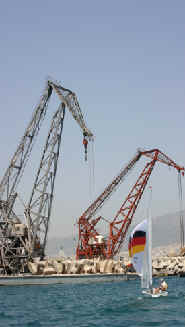| May the Force (of wind) be with you! |
|
This year’s Spa regatta had two days of heavy air racing. As long as everything and everybody on board stayed in one piece it produced a very nice practice of heavy air sailing, especially since Hyeres was such a briljant light air event.
It was quite obvious that most of the sailors were out of practice. Capsizing and putting up boats quickly because of the shallow depth there is at Medemblik. Many masts were either bent or broken because of this. For those who did manage to stay upright, but the “art of heavy air racing” still seemed to be forgotten a bit, here’s the following article.
|
|
|

|
|
Photo
by Coachworks
|
|
Well, What’s the difference?
Heavy air sailing is probably 90% boathandling and 10% equipment or setup, which makes it also quite easy.
So what’s the big fuzz about it? Or what’s the big difference with light air sailing? Is the boat following different principles like: “Is it going to windward if you let it heel to windward?” Or: “Is it getting lighter on the helm if you let it heel ???”
No, no, no!! All the rules of physics remain the same whether it blows or not!! They just are a bit bigger!!
The only extra dimension could maybe just be the aspect of fear and maybe bad physical shape.
Knowing your set up for depowering the sails should be know otherwise don’t go out there.
In single handed dinghies with a cat rig (unstayed) that mostly means giving the mast just a touch more rake in order to open up the leech and have the boat just sail with a lower working sail area. A very good insight is presented at the web site from WB Sail makers ( www.wb-sails.fi ).
In stayed dinghies it also means dropping the mast but keep the tension on the stayes and the speaders alligned (or just a touch to the back of it) with the mast attachment and the boat attachment thus controling the sideway bent.
The rest of it is having the right systems on vang, forestay, outhaul etc. So that when it comes to bussiness, you can really put on some tension while sailing, in order to get the sail flat and controlable.
Fear can drag you to the dark side
Mentally you need to be fully psyched up in order to sail the boat instead of the boat sailing with you on it. Fear mostly gives all the wrong reactions in the body. So be pumped up before you launch the boat. Double check the gear and go for it. But don’t forget: “speed is stability” and “speed means less forces on the rig” (Sorry Yngling girls but yes; the same still goes for you too)
So go for speed and manouvre when the speed is the highest and starts to drop especially gybing.
Because of the forces being bigger, small changes have big consequences. Apparent wind angles will change big time and if your not fast or strong enough the sails plus boat will sometimes shudder. No worries. It just meant that you either were to slow to early or too late with sheeting, steering etc.
Get of your lazy butt!!! You need to hike harder, anticipate, react with the reflexes of a Yedi master (Star wars is in I believe….). So get in the gym start training in heavy air and go for it!
May the force be with you!!
Good winds
|